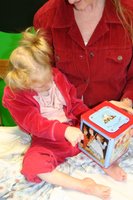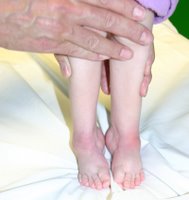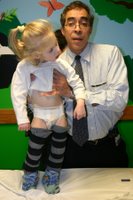 On November 20th we got Ellie’s 3rd set of casts taken off. This set kept her feet just a few degrees shy of neutral for one week and were her most comfortable set. These were removed with the dreaded saw and made into Bivalves. Bivalves are casts that have been made into a brace that can be taken on and off. About half of the padding/gauze that existed in the cast is taken out and replaced with a cotton lining and straps on the outside to hold them on. They were wildly uncomfortable for Ellie and we had to give her feet a break the second night because her poor feet were swollen and bruised. The next morning it was like she had new feet they were so improved. After those first couple of bad nights she settled into these with a little
On November 20th we got Ellie’s 3rd set of casts taken off. This set kept her feet just a few degrees shy of neutral for one week and were her most comfortable set. These were removed with the dreaded saw and made into Bivalves. Bivalves are casts that have been made into a brace that can be taken on and off. About half of the padding/gauze that existed in the cast is taken out and replaced with a cotton lining and straps on the outside to hold them on. They were wildly uncomfortable for Ellie and we had to give her feet a break the second night because her poor feet were swollen and bruised. The next morning it was like she had new feet they were so improved. After those first couple of bad nights she settled into these with a little  added padding we added.
added padding we added.  They are a stop gap measure and because there is some play in them we were not able to practice standing.
They are a stop gap measure and because there is some play in them we were not able to practice standing.After they decasted her, Tom, the expert orthodics guy, created molds of her feet and legs our of plaster paris. Ellie sailed through this and was easily distracted by reading her books.
 Dr. Webster was his ever attentative self and was very pleased with the progress made with Ellie’s feet. And I have to agree – it’s amazing the difference. She went from having severely clubbed feet to being able to get them into a neutral position in under two months time.
Dr. Webster was his ever attentative self and was very pleased with the progress made with Ellie’s feet. And I have to agree – it’s amazing the difference. She went from having severely clubbed feet to being able to get them into a neutral position in under two months time.
She also has picked up the new skill along the way of being able to turn the handle of her “Raggedy Ann” jack in the box. This indicates a neurological leap, believe it or not. The ability to turn a handle round and round takes a new level of neurological complexity. Yay for all milestones! I am not sure if being upright, even if infrequently, had anything to do with it. But I can’t help think that having a new perspective will help her development.
Casting Part 4: AFOs
 Today we went back to the Floating hospital to pick up Ellie’s AFOs. Her feet are still much improved after having worn the bivalves for the better part of 23 hours per day for one week. We were there for four hours because they had to tweak them when Ellie’s feet would show signs of pressure. They also tweaked her bivalves to make them more comfortable for her.
Today we went back to the Floating hospital to pick up Ellie’s AFOs. Her feet are still much improved after having worn the bivalves for the better part of 23 hours per day for one week. We were there for four hours because they had to tweak them when Ellie’s feet would show signs of pressure. They also tweaked her bivalves to make them more comfortable for her.The Plan
1. Break them in slowly. The plastic of the AFO’s is way less forgiving than the casts or bivalves. Because they can be taken off they are intended to be more corrective. The casting was serial because you can’t take them off so they can’t stretch the child’s foot too much because of the pain. But AFO’s are intended to put Ellie’s feet in neutral so that she can stand in them. By standing on them the hope is that they will correct even further. You can see by this picture when she was a couple of months old corrected age, -1 month actual age, that her feet were perfect when she was born but have been pulled out of place by her spasticity as I explained here.
 To break these in slowly we will start her on 30 minutes on and then take them off and make sure there is no redness. We will do this twice the first day and then 4 times the next. After that we will see how she does after one hour then the next day after two hours and so on. In between she will wear the bivalves.
To break these in slowly we will start her on 30 minutes on and then take them off and make sure there is no redness. We will do this twice the first day and then 4 times the next. After that we will see how she does after one hour then the next day after two hours and so on. In between she will wear the bivalves.The goal is to have her in her AFOs all day and let her sleep in the bivalves because they are made of cotton and can breath.
2. Gait Training. We will be getting Ellie a gait trainer which is a metal frame with straps that will hold her upright and bear her weight but allow her to get from place to place by using her legs and feet.
 3. Dr. Webster was very clear that Ellie needed a power wheelchair. This is exciting news in that we were not sure she could operate one. He thin sliced that she could and felt that being able to explore her world of her own volition would create better feedback loops and help her brian develop.
3. Dr. Webster was very clear that Ellie needed a power wheelchair. This is exciting news in that we were not sure she could operate one. He thin sliced that she could and felt that being able to explore her world of her own volition would create better feedback loops and help her brian develop.4. Getting her a soft spinal orthosis to help support her spine is also being considered when we get to the point when she is standing.
5. Knee immobilizers. You can see them here – they are the gray things with the black strips. We need to put those on her when she sleeps to protect her knees. Her knees and the alignment of her legs have been a huge concern for me in this whole process. I have not been successful in teaching Ellie the idea of pain – so she can’t tell me when she is in pain other than to cry and be out of sorts. But she can’t tell me where the pain is – which is very troublesome since we have entered into the business of tweaking her body.
The Conundrum: A Paradigm Clash
The logic that is worrying me is the paradigm I subscribe too that says that Ellie’s body and the shape of her feet are in balance with where her body is. If we put her in positions her body is not ready for it could be injured permanently leading to more medical interventions. I have seen this born out with getting the g-tube and the huge increase in reflux that caused. It is true that if you sit someone in a sitting position who is not strong enough to hold themselves up their spine will curve. This started to happen to Ellie but then I made sure that everyone put her on her tummy as much as possible and guess what, her spine straighten out. I have heard horror stories and seen a couple of kids with CP who have had metal rods put up their spines for this very reason. These rods subject them to a lifetime of pain and a shorter life as well. But they are sure easier to manage for the caregiver.
The Other Paradigm: Management Paradigm
The management of these kids for the caregiver is the impetus behind many medical interventions we found. It is not about healing them – it’s about making them easier to deal with for their caregivers. This horrified me when I first realized it. I am all about Ellie healing. That is why I do the nutritional, Oxygen and Neuro-respiratory Therapies. It’s why I assume she knows more than less. I want to create an atmosphere, physical, emotional, and spiritual environment in our lives in which she can live up to her highest potential.
I started this whole botox casting journey because I felt that if I let the spasticity pull her
 once perfectly straight feet into permanent deformity that would close the door forever on her walking. Ellie wearing braces will allow me to put her in a gait trainer and a stander. But if she is in them too much her feet will get weaker. Wearing the casts have already weakened her feet – though strengthen her thigh muscles. This weakening of the muscles due to leg and feet braces or AFOs was confirmed for me by a mother whose child with CP is a lot older than Ellie and can speak. She told her mother that her feet are weaker if she always wears the braces all the time. Thank God today I saw Dr. Webster put Ellie on her own feet, sans braces, to see how she would do.
once perfectly straight feet into permanent deformity that would close the door forever on her walking. Ellie wearing braces will allow me to put her in a gait trainer and a stander. But if she is in them too much her feet will get weaker. Wearing the casts have already weakened her feet – though strengthen her thigh muscles. This weakening of the muscles due to leg and feet braces or AFOs was confirmed for me by a mother whose child with CP is a lot older than Ellie and can speak. She told her mother that her feet are weaker if she always wears the braces all the time. Thank God today I saw Dr. Webster put Ellie on her own feet, sans braces, to see how she would do.The Go-Forward Challenge
Balancing between the two paradigms so that Ellie bearing weight can help correct her feet even more without curving her spine or distorting the straightness of her leg and wrecking her knees. A balance will have to be found between the “skeletal” like support AFOs will give her with the weakening of her muscles.
 How will we do this? I am not totally sure but right now I know that I need to keep doing a lot of tummy time with her. I will have to see how much time she can spend with her feet free. I am not sure. I do know that Ellie is still going to be spending most of her time on the floor, rolling, side lying and on her tummy. That is her gym and the key to her getting stronger. I am not going to have her strapped into metal equipment all day. I just want to give her feet time while waiting for her healing circulatory system and brain to catch up. If you have any suggestions, please share them here. I am all ears.
How will we do this? I am not totally sure but right now I know that I need to keep doing a lot of tummy time with her. I will have to see how much time she can spend with her feet free. I am not sure. I do know that Ellie is still going to be spending most of her time on the floor, rolling, side lying and on her tummy. That is her gym and the key to her getting stronger. I am not going to have her strapped into metal equipment all day. I just want to give her feet time while waiting for her healing circulatory system and brain to catch up. If you have any suggestions, please share them here. I am all ears.